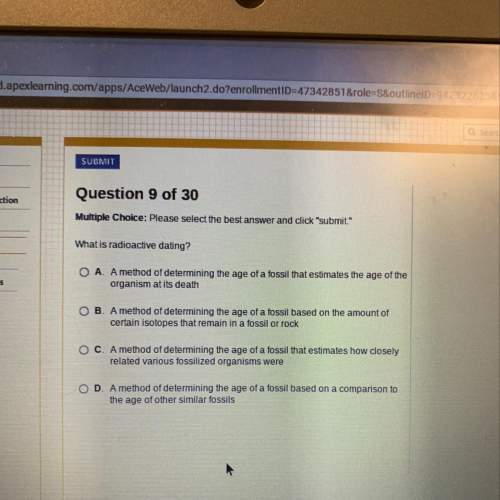
3) What happens to the carbon in glucose or any other metabolized material?
a. It becomes part of pyruvate and then lactic acid which is filtered by your blood.
b. It is broken down into its smallest form and expelled as carbon dioxide.
Carbon is broken down and used for energy leaving only H+ ions which eventually form
water
d. Both A and B are correct
e. All of the above
C.

Answers: 2
Another question on Biology

Biology, 21.06.2019 19:30
The diagram below represents a marine food web and a process that can harm the human population. each circle represents an organism and the smaller dots inside them represent a toxic substance. what is being represented and how does it harm the population? the diagram represents biological half-life, in which toxins build up in organisms higher up on the food chain, and this can negatively impact humans who consume the organisms and the toxic substance. the diagram represents biomagnification, in which toxins build up in organisms higher up on the food chain, and this can negatively impact humans who consume the organisms and the toxic substance. the diagram represents the process by which different organisms prey upon each other; this can impact the human population by reducing the number of organisms that do not contain the toxin. the diagram represents the way that toxins are metabolized by living organisms, with those at greater trophic levels able to metabolize more efficiently than those at lower levels. this means that those at higher tropic levels are safer for humans to consume compared to the organisms at lower trophic levels.
Answers: 1

Biology, 21.06.2019 23:30
If you have a difficult time knowing where your hand is without looking at it you may be having a problem with your what ?
Answers: 1

Biology, 22.06.2019 01:10
Osmosis is often viewed incorrectly as a process driven directly by differences in solute concentration across a selectively permeable membrane. what really drives osmosis? view available hint(s)osmosis is often viewed incorrectly as a process driven directly by differences in solute concentration across a selectively permeable membrane. what really drives osmosis? the first law of thermodynamicsthe difference in the height of water columns on either side of a selectively permeable membranethe difference in water concentration across a selectively permeable membranethe difference in sugar or ion concentration across a selectively permeable membrane
Answers: 2

Biology, 22.06.2019 02:00
Ateam from new york presbyterian hospital is conducting a study about a recent increase in cases involving both excess sweating and kidney stones. what would the team need before it draws a conclusion about the cases? medications that are specifically designed to treat the sickness machines that are built to process blood and reduce symptoms until patients are healthy again data that profile the various patients who report these symptoms proof that the excess sweating is related to the excessive kidney stones
Answers: 2
You know the right answer?
3) What happens to the carbon in glucose or any other metabolized material?
a. It becomes part of...
Questions

Mathematics, 22.02.2022 14:00

Mathematics, 22.02.2022 14:00


English, 22.02.2022 14:00


English, 22.02.2022 14:00

Biology, 22.02.2022 14:00

English, 22.02.2022 14:00


Computers and Technology, 22.02.2022 14:00


Mathematics, 22.02.2022 14:00


Mathematics, 22.02.2022 14:00




Mathematics, 22.02.2022 14:00

Spanish, 22.02.2022 14:00




